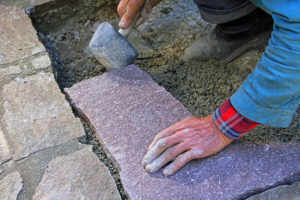 If you are considering building a patio but have been hesitant to do so because patios require cement, don’t give up on the idea. A patio can be built without cement. You’ll need a well-prepared base that you use to support brick, tile, flagstone, or another reliable material. This will be cheaper than cement, water permeable and environmentally friendly. Most importantly, your new patio will look good. Cement looks far too plain and drab. You’ll love the aesthetic of a rich red brick or colored tile. You’ll even be able to dig up this patio if you want to move its location at some point in the future.
If you are considering building a patio but have been hesitant to do so because patios require cement, don’t give up on the idea. A patio can be built without cement. You’ll need a well-prepared base that you use to support brick, tile, flagstone, or another reliable material. This will be cheaper than cement, water permeable and environmentally friendly. Most importantly, your new patio will look good. Cement looks far too plain and drab. You’ll love the aesthetic of a rich red brick or colored tile. You’ll even be able to dig up this patio if you want to move its location at some point in the future.
Materials For Building Patios
The first step is to choose the paving material that you would like to use for your space. Most hardware stores have a variety of paving materials. Buy enough to fit the area that you’ve designated for your patio. If you opt for bricks, be aware that the cheapest variety are called paving bricks and they are actually made from concrete. The costliest bricks have mortar or plaster on them to add character. Ask the supplier to deliver the bricks because they’ll be too heavy for your car. Also, have the sand delivered to your home as well. You’ll need a lot and if you transport it yourself, it’ll take several trips. It’s difficult to determine how much sand you’ll need. If you want to build a 12 foot square patio, you’ll likely need one ton of sand.
Patios Require Good Drainage
If you have excellent drainage, you won’t have to dig very deep into the ground. Those with optimal drainage will only have to dig a couple inches. The majority of drainage should be capable of handling 4 to 8 inches. Be sure to remove all rocks and roots from the area. Keep in mind that if you dig deeper than you need to, it will reinforce the stability of the area.
Proceed to line the perimeter’s edges with bender board. Keep it held in place momentarily with stakes. Then spray the area with a light amount of water. Fill in the bottom with a road base about 2 to 4 inches deep. You can also use crushed recycled cement or a ¾ inch gravel if you’d like. Many people choose to layer this area with a weed cloth. Weeds can be pulled fairly easily without the cloth though. Also, if your pavers have multiple thicknesses, the weed cloth will make it difficult to set them evenly. Spray the area with the hose once again.
Next, add 2 to 4 inches of sharp sand. Set your pavers together with the desired gap in between them. If you let large gaps remain, you’ll have to fill the resulting cracks with decorative gravel, river rock or ground cover plants. Those who decide to use flagstone will need to shape and chip a lot in order for the stone to fit close together. Another light spray with the hose at this point is ideal.
Fill the spaces between the cracks with sand. Keep filling it generously until it flows over. Now you should wait a few days so that the sand settles nicely into the cracks. Once this time has passed sweep it over. Water it once again with a light spray. If you’d like to use ground cover plants to fill the large gaps, this is the time to plant them. Those who decide to fill the spaces with decorative gravel can apply the filling material and not worry about applying sand until it overflows. Once you’ve finished, spray it with the hose one last time.
